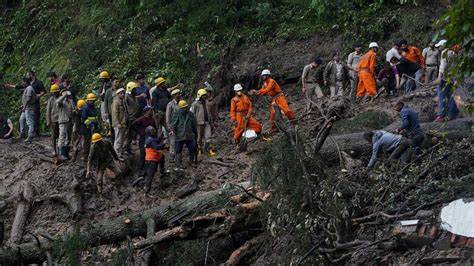Heavy rains trigger floods and landslides in India’s Himalayan region, leaving at least 48 dead

Heavy rains trigger floods and landslides in India’s Himalayan region, leaving at least 48 dead
Severe monsoon rains have set off devastating floods and landslides in India’s Himalayan region, resulting in a tragic loss of life. According to reports from local officials shared on Monday, the death toll has risen to at least 48 people, with numerous individuals still trapped in precarious situations.
The heavy rainfall, which began over the weekend, has particularly impacted the mountainous state of Himachal Pradesh. The torrential downpours have inundated roads and swept away homes, leaving behind scenes of destruction. In response to this dire situation, rescue teams have been working tirelessly to assist those who are stranded or buried beneath the debris caused by landslides.
One of the worst-hit areas is the Mandi district in Himachal Pradesh, where rescuers have already recovered the bodies of 19 victims. This grim situation highlights the urgency of the ongoing rescue efforts as well as the significant challenges posed by the intense monsoon rains and resulting natural disasters in the region.
The capital city of Shimla has faced significant devastation due to the ongoing natural disasters. Two landslides and a sudden and intense bout of rain, known as a cloudburst, have led to a tragic loss of life. The combined impact of these events has resulted in the deaths of 14 individuals.
Additionally, the state’s Solan district was severely affected by a cloudburst, which claimed the lives of nine people in the area. As the situation unfolds, the death toll has risen consistently throughout the day. The continuous heavy rains across various parts of the state have triggered flash floods and exacerbated the occurrence of landslides, contributing to the worsening crisis.

Sukhvinder Singh Sukhu, the Chief Minister of the state, reported that rescue teams in Shimla are diligently working to clear away the debris and provide assistance to those who remain trapped. The relentless efforts of these rescue teams underscore the urgency of the situation and the dedication of authorities to mitigate the impact of these disastrous events and offer aid to the affected communities.
Cloudbursts are characterized by an extraordinary amount of rainfall, exceeding 10 centimeters (3.9 inches), that takes place within a relatively small area of 10 square kilometers (3.8 square miles) in just an hour.
These meteorological events are not uncommon in the Himalayan regions, where their occurrence has the potential to trigger severe consequences such as intense flooding and landslides. The devastating impact of cloudbursts can affect a large number of people and pose significant challenges to rescue and relief efforts.
In the current situation, the relentless cloudbursts have led to widespread devastation. In the Solan area, homes were swept away by the force of the water, and roads were submerged due to the incessant rainfall. In Shimla, the landslides were particularly destructive, even causing the collapse of a Hindu temple that was crowded with devotees at the time. This raises concerns about a potential increase in the death toll as rescue operations continue.
The incidents in Solan and Shimla serve as a stark reminder of the destructive power of natural disasters, especially in regions vulnerable to such meteorological events. The challenges presented by the simultaneous occurrence of cloudbursts, floods, and landslides underscore the need for timely and effective rescue efforts to safeguard lives and mitigate the impact on affected communities.
In response to the severe weather conditions and the ongoing natural disasters, authorities have taken several measures to ensure the safety of the population. All schools and colleges in the affected state have been closed down to prevent any risks associated with the adverse weather conditions. Furthermore, due to the extensive flooding, more than 700 roads have been inundated and rendered impassable, adding to the challenges faced by both the authorities and the affected individuals.
The Indian meteorological department has issued a warning about the prevailing weather conditions. Moderate to heavy rainfall has been reported across various parts of the state on Monday. These weather conditions are expected to persist, with rain likely to continue until the end of the week. In anticipation of the prolonged rainfall and its potential consequences, the meteorological department had previously issued a red alert over the weekend, signaling the likelihood of intense downpours in the neighboring Uttarakhand state. Unfortunately, Uttarakhand has already experienced the tragic loss of 60 lives due to monsoon rains this season.
The ongoing challenges and the prediction of further rainfall highlight the critical need for preparedness, swift rescue operations, and sustained relief efforts to ensure the safety and well-being of the affected population.
The previous month saw a tragic episode as unprecedented monsoon rainfall claimed the lives of more than 100 individuals over a span of two weeks. This calamity struck various regions in northern India, with Himachal Pradesh being among the hardest hit areas.
Landslides and floods, triggered by heavy rains, have regrettably become recurring events in the Himalayan northern part of India during the monsoon season, which spans from June to September. Unfortunately, these disasters have been increasing in frequency, a phenomenon attributed in part to global warming and the resultant melting of glaciers in the region.
It’s noteworthy that the consequences of such events are far-reaching. In February 2021, Uttarakhand, a state neighboring the current disaster-affected region, experienced flash floods that claimed the lives of nearly 200 people and caused extensive destruction by washing away homes.
These devastating events underscore the urgency of addressing climate change and its ramifications. While landslides, floods, and other natural disasters have historically been part of the monsoon season, their heightened frequency and intensity demonstrate the critical need for mitigation efforts and adaptive strategies to safeguard vulnerable communities.




